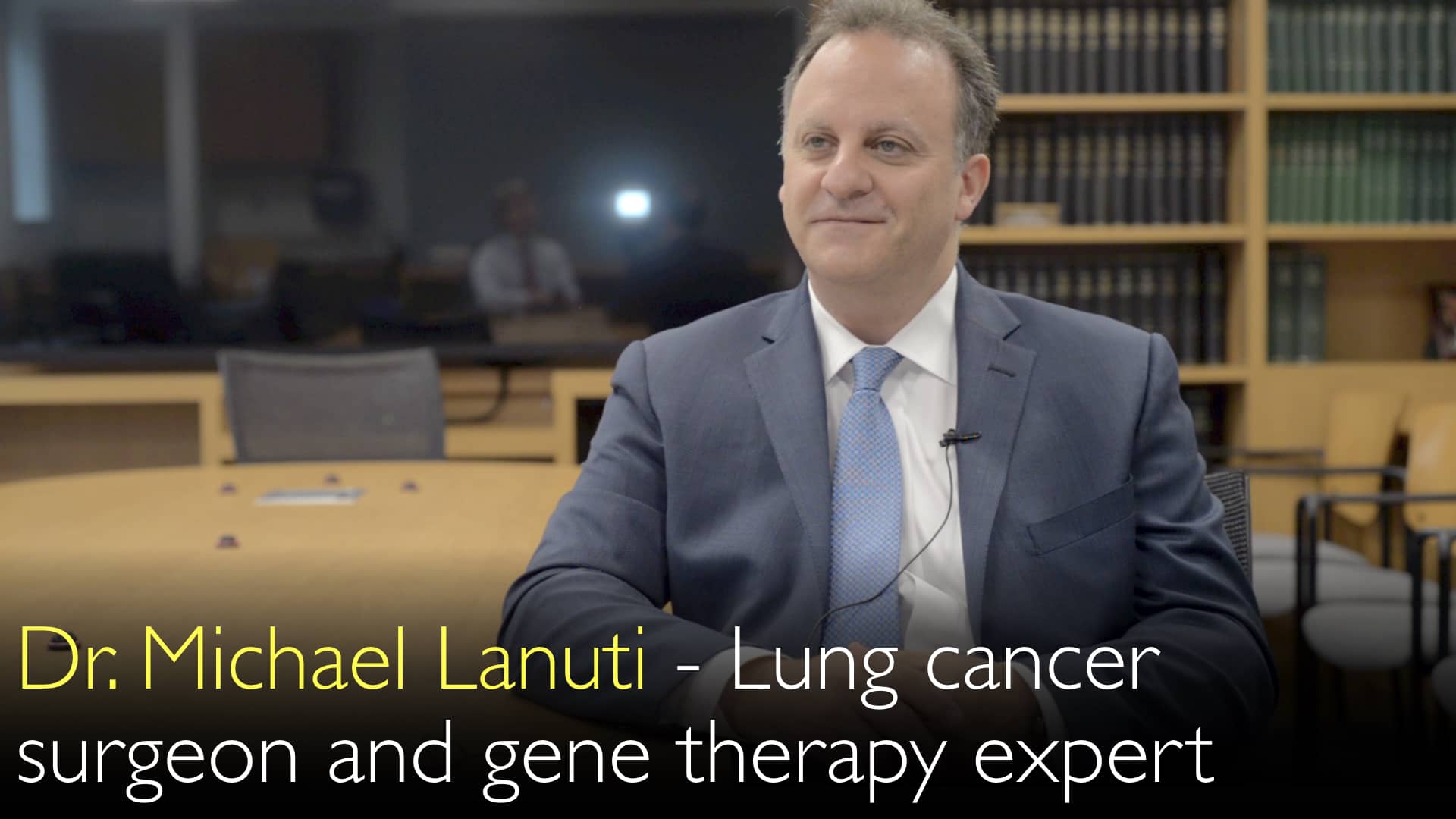מומחה מוביל בכירורגיית חזה, ד"ר מייקל לנוטי, MD, מסביר את האסטרטגיות האבחוניות והטיפוליות המורכבות עבור מטופלים המגיעים עם מספר נודולות ריאה בסריקת CT. הוא מפרט כיצד להבחין בין מחלה גרורתית לבין מספר סרטני ריאה ראשוניים, תוך הדגשת התפקיד הקריטי של מומחה לסרטן ריאה בהחלטה האם לעקוב, לבצע ביופסיה, או לבצע כריתה כירורגית חוסכת רקמה ריאתית כמו כריתת מקטע או כריתת טריז לשימור תפקוד הריאה.
אבחון ואסטרטגיות טיפול בגושים ריאתיים מרובים
קפיצה לפרק
- מאפייני גושים מרובים
- הקשר היסטוריית המטופל
- הבחנה בין סוגי גושים
- אסטרטגיית הערכת סיכון
- חשיבות המומחה
- ניתוח חוסך רקמת ריאה
מאפייני גושים מרובים
תרחיש שכיח ומורכב באונקולוגיה חזה הוא גילוי גושים ריאתיים מרובים בסריקת CT. כפי שמסביר ד"ר מייקל לאנוטי, MD, מטופלים לרוב מגיעים לא עם גוש בודד אלא עם מספר גושים, מה שמסבך משמעותית את תהליך האבחון. למטופלים אלה עשויה להיות היסטוריה של עישון או להיות לא-מעשנים, והגישה הקלינית חייבת להיות מותאמת לנסיבות הייחודיות של כל פרט.
נוכחות גושים מרובים מעלה מיד שאלות לגבי מקורם והקשר ביניהם. ד"ר מייקל לאנוטי, MD, מציין שכל גוש יכול לייצג סרטן ריאה ראשוני עצמאי, או שהם עשויים להיות קשורים, כמו התפשטות גרורתית מגידול ראשוני בודד. הערכה ראשונית זו היא הצעד הראשון הקריטי בפיתוח תוכנית טיפול יעילה.
הקשר היסטוריית המטופל
היסטוריה רפואית של המטופל מספקת הקשר חיוני לפרשנות גושים ריאתיים מרובים. ד"ר מייקל לאנוטי, MD, ממחיש זאת עם שתי דוגמאות שונות. מטופל עם היסטוריה קודמת של סרקומה, סוג סרטן שלעיתים קרובות מפתח גרורות לריאות, יוביל רופא לחשוד strongly במחלה גרורתית כאשר מופיעים גושים ריאתיים חדשים.
לעומת זאת, מעשן בן 60 ללא היסטוריה קודמת של סרטן שמגיע עם גושים ריאתיים מרובים אך ללא מסה דומיננטית מציג חידת אבחון שונה. במקרה זה, הסבירות שזהו סרטן ריאה גרורתי שלב 4 נמוכה יותר, ומעבירה את המיקוד לאפשרות של סרטן ריאה ראשוני סינכרוני מרובה, הדורש אסטרטגיית טיפול שונה לחלוטין.
הבחנה בין סוגי גושים
מאפיינים רדיולוגיים של הגושים עצמם הם בעלי חשיבות עליונה לאבחון. ד"ר מייקל לאנוטי, MD, מדגיש שגושים ריאתיים מוצקים מטופלים very differently מגושים תת-מוצקים (הכוללים אטימות זכוכית matt). גושים מוצקים לרוב דורשים התערבות מיידית יותר, בעוד שגושים תת-מוצקים מסוימים יכולים להיות מועמדים לתקופה של ניטור פעיל עם הדמיית CT חוזרת.
ההתנהגות הביולוגית וסיכון הסרטן הקשורים לסוגי גושים אלה משתנים greatly. הבנת הבדלים אלה מאפשרת לצוות הטיפול לקבוע עדיפויות לאילו גושים מהווים את האיום המיידי ביותר ודורשים את תשומת הלב הדחופה ביותר במהלך הבירור האבחוני.
אסטרטגיית הערכת סיכון
אסטרטגיה מרכזית בניהול גושים ריאתיים מרובים היא התמקדות first בנגע האגרסיבי או בסיכון הגבוה ביותר. ד"ר מייקל לאנוטי, MD, מתאר תהליך שבו, אם קיימים שלושה גושים, הצוות הקליני יזהה את זה עם התכונות החשודות ביותר לסרטן. זה הופך ליעד העיקרי לביופסיה או כריתה.
גישה זו אינה意味着 שהגושים האחרים מתבטלים. הרופא המטפל חייב continuously להעריך האם הגושים האחרים יכולים להיות משקעים גרורתיים מהנגע הראשוני או סרטן ראשוני עצמאי בעצמם. הערכת סיכון מורכבת זו היא דינמית ומתפתחת ככל שנאסף מידע אבחוני נוסף.
חשיבות המומחה
המורכבות של מקרים אלה מדגישה את החשיבות החיונית של התייעצות עם מומחה טיפול בסרטן ריאה ייעודי. כפי שציין ד"ר מייקל לאנוטי, MD, סוג זה של מצב קליני מורכב cannot be managed well על ידי רופאים שאינם מומחים באבחון וטיפול בסרטן ריאה.
צוות רב-מקצועי, הכולל מנתח חזה, אונקולוג רפואי, פולמונולוג ורדיולוג, הוא essential לבדיקת הדימות, הפתולוגיה וגורמי המטופל כדי לגבש consensus על הדרך האבחונית והטיפולית הטובה ביותר קדימה. גישה שיתופית זו מבטיחה את סטנדרט הטיפול הגבוה ביותר.
ניתוח חוסך רקמת ריאה
כאשר ניתוח is indicated עבור סרטן ריאה ראשוני סינכרוני מרובה, אסטרטגיה כירורגית חייבת to prioritize שימור תפקוד הריאה. ד"ר מייקל לאנוטי, MD, highlights שמנתחים need to spare רקמת ריאה. זה often means סטייה מלובקטומיה סטנדרטית וביצוע instead כריתות מקטע אנטומיות או כריתות טריז.
הליכים חוסכי ריאה אלה, while potentially פחות מלובקטומיה מלאה, הם crucial לשימור איכות החיים ויכולת הנשימה של המטופל, especially אם ניתוחים עתידיים על הריאה הנותרת become necessary. גישה מתחשבת זו לתכנון כירורגי היא hallmark של טיפול אונקולוגי חזה מומחה.
תמלול מלא
ד"ר אנטון טיטוב, MD: נמצאים גושים ריאתיים מרובים בסריקת CT. מנתח סרטן ריאה discusses אפשרויות אבחון וטיפול עבור מטופלים עם וללא היסטוריה של סרטן, כולל גושים ריאתיים מוצקים ותת-מוצקים.
האם אולי יש מקרה קליני שתוכל discuss? מקרה קליני would illustrate חלק מהנקודות discussed היום. אולי תוכל discuss מטופל עם סרטן ריאה או עם גושים ריאתיים?
ד"ר מייקל לאנוטי, MD: כן, אחד המקרים השכיחים שאנחנו often see הוא מטופל שמגיע not עם גוש ריאתי אחד, אלא עם גושים ריאתיים מרובים. זה מצב fairly common. הם could be מעשן או not, ולכן we have to manage גושים ריאתיים מרובים.
I think it's important to know how to manage גושים ריאתיים מרובים well.
ד"ר אנטון טיטוב, MD: Sometimes you're seeing גושים מרובים. Then כל גוש ריאתי can be סיכון עצמאי, or they can be related. הרופא המטפל must understand that in the context of המטופל.
For example, sometimes המטופל has היסטוריה קודמת של סרקומה and they have גושים ריאתיים מרובים. Then you worry about סרקומה גרורתית. Sometimes המטופל is מעשן and they never had היסטוריה של סרטן. Then you have to ask: מה מהות כל גוש ריאתי? Does כל גוש ריאתי represent ישות עצמאית or something that's related? Could it be סרטן ריאה גרורתי?
ד"ר מייקל לאנוטי, MD: מטופל בן 60 עם no היסטוריית סרטן but who's מעשן now has גושים מרובים, but מטופל זה does not have מסת ריאה דומיננטית. Then הסיכויים של that being סרטן ריאה שלב 4 is low. On the other hand, what are they?
If they're גושים ריאתיים מוצקים, you manage them differently than if they're גושים ריאתיים תת-מוצקים. Sometimes we watch מרובים, let's say שלושה, גושים ריאתיים. Then we tend to choose הגוש הריאתי that's more aggressive, the one that's higher risk for סרטן ריאה, and we focus our attention on that גוש.
We treat that aggressively. So it might be that הגושים הריאתיים האחרים take a backseat, but you're not dismissing גושים ריאתיים אחרים. You always have to figure out: could הגושים הריאתיים האחרים be גרורתיים or not?
That type of nuance really deserves מומחה טיפול אמיתי בסרטן ריאה. That situation can't be managed well with רופאים that aren't מומחים באבחון וטיפול בסרטן ריאה.
Frankly, מנתחים need to spare ריאה if they're worried about סרטן ריאה ראשוני סינכרוני מרובה. So they need to do things that are going to spare a ריאה. They have to do כריתת מקטע, which is כריתה כירורגית של מקטע ריאה. They have to do כריתות טריז ריאתיות, which is פחות מכריתת אונה.
That's certainly מקרה very relevant and very interesting!
ד"ר אנטון טיטוב, MD: כן. ד"ר מייקל לאנוטי, MD, thank you very much for this conversation. It will be very interesting for אנשים around the world. Thank you for curing my mother from a גידול ריאה!
ד"ר מייקל לאנוטي, MD: You're welcome! Thank you for inviting me.





